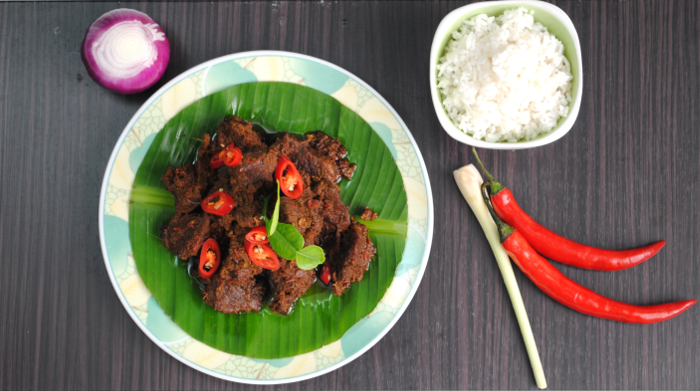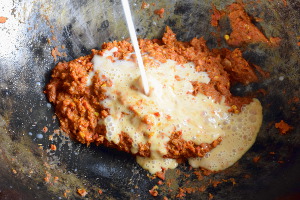Do you know what the world’s best foods are? Sushi, beef rendang, or lasagne? You probably thought you knew, but most likely you don’t.
If you chose rendang, congratulations! Based on 35,000 votes, the world’s most delicious food is rendang from West Sumatra, Indonesia.
CNN scoured the planet to create the list of 50 most delicious foods in 2011, and rendang took the top position on the list.
Note: This post may contain affiliate links. Please read my privacy policy for more info. I may receive commissions for purchases made through links in this post. As an Amazon Associate, I earn from qualifying purchases.
Introducing the best rendang- rendang minang from Sumatra
Beef rendang is one of the original cuisines of Minangkabau descent and Sumatra’s culture. It is served on special occasions to honor guests and during festive seasons. It is a delicious Indonesian dish prepared with many herbs and spices. Slow cooking for a few hours until all the liquids have been completely absorbed by the meat. Beef rendang is best eaten with steamed rice and condiments such as fried onions and chili.
Here is the good news. You do not need to travel to Sumatra, Indonesia. Following this beef rendang recipe, you can recreate the world’s best food at home.
This recipe is the authentic beef rendang recipe from the native land of Rendang in Minangkabau, tested in my kitchen based on several original recipes written in Bahasa Indonesia (the Indonesian language). It has also become a common Malaysian dish and is popular during major festivals such as Eid al-Fitr.


Making beef rendang (Update 2023)
After publishing this recipe in early 2017, I received many comments and inquiries. There are two problems readers encountered which I would like to provide further explanation.
Use the right type of chili.


We use the red chili, as shown in the image. There was an incident where a reader mentioned that the amount of chili was way too much. I guess he might have used other types of chili, such as bird’s eye chili!
If you use the red chili as shown, which is the local Serrano chili, the amount should be OK (300g for 1kg of beef). I prefer removing the seed and pith to reduce the hotness and retain the flavor. If you prefer to be less spicy, reduce the amount to 200g.
Cut the galangal into small pieces.


Why is it necessary to do this since we will blend the galangal with the food processor anyway? That is where the problem arises. Before sauteing, you must blend the galangal, garlic, onions, and chili. You want these aromatics and other spices to cook down to become a paste that will stick to the beef.


All these ingredients can cook down easily, but NOT galangal! The larger pieces of galangal will not disintegrate even after a slow cook for four hours. The result will be a mouthful of unpalatable chunks of galangal, which you want to spit out, which is quite disturbing!
Besides that, this delightful Indonesian dish has won the hearts of so many gastronomes. Try it out at home; I don’t think anyone will regret it.
Step-by-step instructions (with photos)


Step 1: Cut the beef. Cut the beef into 4 cm squares, half cm thick. Do not cut the beef too small as the meat can break into smaller pieces during cooking.


Step 2: Blend the spice. Blend all the ingredients B in the recipe, and set the blend aside. You can get most of these spices at Asian markets. You can use ground spices if whole spices are unavailable. Please check the expiry date to get the freshest possible ground spices to make rendang.


Step 3: Bash the lemongrass. Remove the green section and the outer sheath of the lemongrass. Use only the white part. Bash them so that the lemongrass to ensure the release of the flavor.


Step 4: Saute the spice. Heat the vegetable oil in a wok. Saute the spice paste (B) over low heat until aromatic.


Step 5: Add coconut milk. Add the coconut milk and lemongrass to curry paste in the wok.


Step 6: Add the beef. Add the beef and cook over medium heat. Bring the coconut milk to a boil.


Step 7: Simmer the beef. Once it is boiled, continue to simmer over low heat. Add water from time to time when the stew is about to dry.


Step 8: Cook until tender and turns into dark brown. Cook until the beef absorbs the flavor of the spices thoroughly and the color turns dark brown. It will take about three hours. You can use an Instant Pot or any other brand of multicooker to shorten the cooking time. Most of the modern multicooker has programmed mode indicated for cooking beef. Please remember using less water if you pressure cook the beef.


Beef Rendang Minang recipe
Ingredients
Ingredients (A)
Ingredients (B)- to blend
Ingredients (C)- Seasonings and Spices
Instructions
- Cut the beef into 4 cm squares, half cm thick. Do not cut the beef too small as the meat can break into smaller pieces during cooking.
- Blend all the ingredients in (B), set the blend aside.
- Remove the green section and the outer sheath of the lemongrass. Use only the white portion. Bash them so that the lemongrass to ensure the release of the flavor.
- Heat up the vegetable oil in a wok. Saute the spice paste (B) over low heat until aromatic.
- Add the coconut cream, turmeric leaves, kaffir lime leaves, asam keping and lemongrass into the wok.
- Add the beef and cook over medium heat. Bring the coconut milk to a boil.
- Once it is boiled, continue simmer over low heat. Add water from time to time when the stew is about to dry.
- Cook until the beef absorbs the flavor of the spices thoroughly and the color turns to dark brown. It will take about three hours.
- Served with rice or bread.
Notes
Note: Since not everyone tolerates the same level of hotness of chili, please reduce the amount and remove the seeds of the chilies if you are not used to spicy food.
Recommended Products
As an Amazon Associate and member of other affiliate programs, I earn from qualifying purchases.
Nutrition Information:
Yield: 5
Serving Size: 1
Amount Per Serving:
Calories: 1533Total Fat: 90gSaturated Fat: 43gTrans Fat: 1gUnsaturated Fat: 39gCholesterol: 187mgSodium: 1863mgCarbohydrates: 125gFiber: 9gSugar: 83gProtein: 64g
This data was provided and calculated by Nutritionix on 1/29/2019
2 types of superior rendang recipe with terrific flavor
There are two types of beef rendang, depending on how much water content is in the dish.
Dried beef rendang
According to the Minangkabau (hence the name Minang rendang) tradition, their authentic beef rendang is a slow-cooked dry curry. Beef rendang is carefully stirred, simmered, and cooked for three to four hours until the coconut milk has evaporated and reduced to become a thick sauce. By then, the meat had absorbed the flavor of the herbs and spices. Dried rendang can be stored at room temperature for three to four weeks. It can even last up to six months if frozen.
Moist beef rendang (kalio)
Moist beef rendang is cooked much shorter than dry beef rendang. The cooking process ends when the coconut milk becomes a thick rendang gravy. Moist rendang is more popular in neighboring countries- Malaysia, Singapore, Brunei, and southern Thailand. One of the exceptions is rendang Tok, found in the state of Perak, Malaysia, which is dry. Most rendang served in Western countries is moist rendang, compared to its original Minang counterpart.
Malaysian rendang is normally cooked for shorter periods and added with kerisik (toasted grated coconut) to thicken the gravy. I have written another recipe for the Malaysian rendang, which is included in the recipe compilation in my eBook.
How to prepare the best beef rendang (12 helpful tips)
It is quite easy to cook rendang Minang, but pay attention to some finer points below to cook the most delicious food in the world successfully.
- Sirloin is the choice for more tender rendang, but the topside or beef chuck (any tougher cuts of meat) is as good since the beef is stewed for about four hours. You can stew the meat longer by adding water until the beef is tender enough. I used the topside in this recipe, and it turned out perfectly.
- Blend the spice mix with an electric blender. You do not need to add water, as the chilies and onions have sufficient water content for blending. Furthermore, it will take longer to saute the spice paste if the water is added.
- Saute the spice paste with vegetable oil on low heat until it turns fragrant. Add coconut milk and stir frequently. The spice paste can scorch easily if left unattended.
- Most Asians use a wok to cook rendang. This is because the beef is cooked by the coconut milk at the bottom of the wok, which is spherical. Alternatively, try to find a pan with a curved bottom to cook rendang if you do not have a wok.
- Cut the beef across the grain by using the sharpest knife you have. If it is too soft, place it back in the freezer until it gets firmer. Since the beef will be cooked for about four hours, the size should not be smaller than 2 cm cubes. Otherwise, the meat will easily break into smaller pieces.
- There is an easy way to peel the ginger and turmeric, which I explained in another post.
- I normally prefer to remove the seeds of the red chili to reduce the hotness. Rendang is not very hot and spicy, but you can always change the chili amount to taste.
- It is best to use freshly pressed coconut milk. You can use canned or carton-packed coconut milk if it is unavailable. Once opened, coconut milk should always be kept in the chiller. You can also divide the coconut milk into smaller portions and freeze them. Fresh coconut milk can be kept for much longer if frozen. I have used frozen coconut milk for making rendang, which is as good as the freshly pressed one after a month.
- Substitute the fresh coriander seeds, turmeric, and cumin with ground powder. It will not make a huge difference to the final taste.
- Use only the pale yellow bulbous bottom part of the lemongrass. The greenish upper part of the stalk has less flavor and should be discarded. Bashing the lemongrass before adding it to the coconut milk will help release the aromatic flavor of the lemongrass into the rendang.
- Assam keping (also called Assam Kandis / gelugur in Indonesia) is available in dry pieces and is extremely sour. Since it is quite similar, you can use tamarind pulp (assam jawa) as a replacement. However, the authenticity of rendang is lost if you substitute it with other souring agents, such as lemon or vinegar. You can omit it if Assam is unavailable. Also, use tamarind paste if the fresh tamarind is unavailable. Some original rendang recipes from Indonesia do not include Assam. Be careful not to add too much Assam, as rendang is not supposed to be too sour. If it is unavailable, add a squeeze of lime juice before serving to give it a slight tangy flavor.
- You need to add some sugar to balance the sourness. Coconut sugar or plan sugar is the best. If not, just use brown sugar.
- Turmeric leaves are another ingredient unavailable in certain parts of the world. If you cannot get turmeric leaves, use two more kaffir lime leaves.


8 bonus tips to get the best result for the beef rendang
The process of cooking rendang is simple. The following tips will be useful to guide you through the process if you are to cook rendang for the first time.
- Start with sauteing the spice paste with oil on low heat. This step aims to fry the spices until they become aromatic lightly. Constantly stir the spice paste, as it can get scorched easily. You may want to add oil for easy sauteing and remove the excess oil during stewing. Stop sauteing when it turns aromatic or if the oil separates from the spice.
- Once the coconut milk reaches boiling point, reduce heat to a minimum.
- Be patient when preparing rendang. The long cooking time will enable the flavor of the coconut milk and spices to be fully absorbed into the beef.
- The liquid will become thick gravy after one to two hours of continuous cooking. If you are preparing moist rendang, stop at this stage.
- Since this is the dry beef rendang recipe, the cooking process should be continued until the liquid has evaporated. This will take about four hours. Add water if it becomes too dry before the end of four hours. The authentic Minang rendang is dry, unlike the moist beef rendang, which is more popular in Malaysia, Singapore, and Western countries.
- The liquid will eventually fully evaporate and completely caramelize. The beef will cook continuously in the remaining oil and absorb all the flavor of the spices.
- The color of the meat will gradually turn darker and eventually become dark brown at the end of four hours. The flavor of the spices and coconut is fully fused with the beef now. You can finally enjoy the flavor of the authentic beef rendang Minang.
- You can garnish rendang with turmeric leaves cut into thin strips, red chilies, and kaffir lime leaves.
More recipes for you
If you like this recipe, I want to suggest other popular Asian dishes for you to try. So here are my picks of some of the most popular recipes from where I live, Malaysia:
- Chicken varuval. Ready to take a bite of the Indian cuisine with the intense flavor? This recipe is popular in Malaysia and loved by everyone!
- Mee Goreng is another great street food of Indian Muslim origin in Malaysia. It is authentically Malaysian and is the typical Indian Malaysian food.
- Wonton soup and noodles. We have our version of wonton noodles, which is different from the wonton soup noodles from Hong Kong. You can get both recipes from this article.
- Chicken Rendang. I have the Chicken rendang recipe for you if you do not eat beef.






